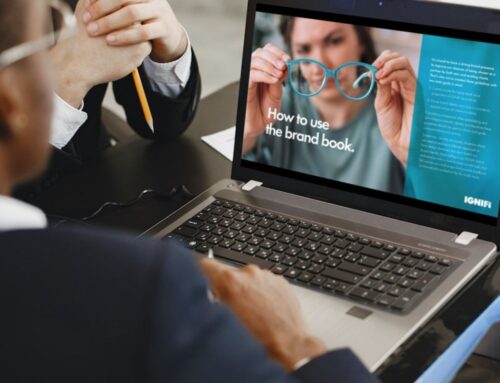
With remote working set to become more commonplace even after restrictions have lifted, it’s important that we optimise our old recruitment processes for a more digital landscape. In this blog, we’re talking about virtual inductions and how to help a new recruit settle into your company without having set foot in the office.
12 months later – what have we learned?
After a year of working from home, we’ve all had to learn how to adapt to virtual working. For some companies, such as Microsoft 1 and BP 2 , this has been such a success that they are looking to adopt a hybrid between home and office work in the coming years. Whether this sees companies introducing flexible working policies or even moving out of their offices for good, it looks like remote working is here to stay.

At IGNIFI, we have found working from home to be a success overall and while we aren’t giving up our offices any time soon, we have adapted our business to incorporate remote, as well as office-based, workers. This meant that we were in the very fortunate position to have been able to continue to expand our team throughout 2020. So far, we have had 5 new recruits join us since we first left No.43 last March, including our first full-time remote working employee, our Medical Copywriter Rudy Sarmah.
This experience has been a learning curve for us, with each new recruit allowing us to build on, and improve, our induction process. Therefore, we want to share our 10 top tips on how to get the most out of your virtual induction process.
Can’t I just carry out my usual induction programme via video calls?
While your usual induction plan may seem well suited to a digital format, some of the key stages of settling into a company in those first few weeks happen outside of any organised meetings. From catch-up chats around the kettle to visualising company structure from the office layout, it’s much harder for the new recruit get a full picture of their job without being in this physical environment.
Our tips are designed not just to make sure that tech is running smoothly but to create connections between team members who have never met each other in person.
10 top tips for a successful virtual induction
1. Have a detailed induction programme planned in advance
Without the ability to immerse the new recruit in office-life, all of the valuable experience gained in this way must be considered and planned in as activities throughout the induction. Create a detailed plan that can be shared with the recruit for feedback ahead of time, giving them a sense of what to expect on their first day.
2. Prepare any tech ahead of time
There’s nothing more stressful than showing up for your first day in a new job, only to realise that your laptop won’t connect to the internet, or that the software you need to use isn’t installed. Get ahead of the game by organising the delivery of any hardware ahead of time and planning in a trial run with the new recruit to check that everything runs smoothly before their official first day.

3. Build awareness of the wider team
Getting to know the company structure can be overwhelming, especially in those first few days, but you can still incorporate visual learning for this part. Try using diagrams to visualise the structure and teams within the company – include photos to help the new recruit put names to faces.
4. Book key introductory meetings in advance
With large parts of the day dedicated to client and internal calls, try and set up appointments with department managers and key personnel in advance. Keep the introductions surface-level for now, concentrating on familiarity and appreciation of the roles to help build a better picture of the business.

5. Build in time for role-familiarisation
While a lot of the induction needs to be spent on admin and introductions to the team, try and build in some time for experience of the role. This can be done through shadowing team members and will give the new recruit a better sense of what their role will involve on a day-to-day basis after the initial training period.
6. Encourage social connections
Don’t forget the social side of the job – building connections with co-workers in these first few days will make it easier to ask for help and promote more open collaboration in the long-run. It can also go a long way to making sure working from home doesn’t feel isolating. Include the new recruit in team-wide calls ASAP for the initial introductions before planning in one-on-one calls.
7. Identify knowledge gaps early
With less one-on-one time, it’s important that the new recruit feels comfortable enough to discuss anything they are unsure about. While oversights and misunderstandings may be easy for a manager to pick up on in the office, this can be harder when working remotely.
8. Keep in contact
While it’s important to give the recruit time on their own to familiarise themselves with the organisation and make a start on tasks, try and combine this with guided sessions by other team members. Balancing independence and support is difficult, so check in regularly to make sure that everything is going to plan.

9. Don’t overload with information in one go
Although it can be tempting to have an extra pair of hands to lighten the workload as soon as possible, make sure you don’t rush through the induction process. This time should be treated as an overview and introduction to the business. Try and focus on the basics and save the in-depth knowledge for the training stage.
10. Plan in a review at the end of the induction period
This allows you and the new team member to reflect on the experience and discuss any knowledge gaps or training opportunities that have been identified. This can then be used to create a training plan for the next stage of their employment, with defined goals and a clear time frame.
Was the induction a success?
Regardless of how your induction plan might look, by the end of this period your new employee should:
- Have a sense of the big picture of the wider team and company
- Understand their daily tasks and be ready to work individually
- Be in regular communication with their team and manager
- Know exactly who to reach out to for extra help
It is likely that many of us will be working from home for a while yet and remote workers are going to become an increasingly common feature of the workforce, so it’s worthwhile getting your digital induction process refined.
Are you looking for your next opportunity? Visit our careers page for a list of our current openings or to submit a CV.








